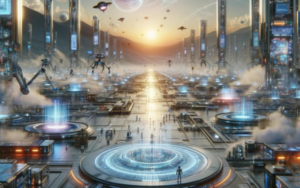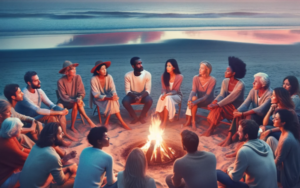Leaving Fear Behind
Everyone is buzzing about the trillion-dollar market opportunity and fearing AI, yet it’s time to consider leaving fear behind. Trusting the right sources is crucial in this delicate time.
While some face the fears of real wars and conflict, many of us have learned to fear not being good enough, caught in endless comparison and judgment.
Meanwhile, some of us have simply had enough and are consciously leaving fear behind. Instead, we are bring curiosity to create what’s possible.
Some of us find health in watching less news, listening less to experts, and not buying into trends. This allows us to listen to our own hearts and stay unaffected by the central stage’s dramas. We’re not ignoring events but becoming more discerning and, sometimes, vocal about whom we trust with our lives, while quietly creating what is necessary.
One show playing out prominently is AI. It appears so powerful that it leads to job losses. Moreover, it’s making an impact closer to home. A recent assessment indicates that ChatGPT uses the energy equivalent to 33,000 homes. A generative AI-driven search consumes four to five times more energy than a conventional web search. Predictions suggest that, within years, large AI systems might require as much energy as entire nations.
It’s becoming clear that stepping into our own divine power is crucial to halt the ongoing insanity of being told who to trust and what to fear.
Not Putting Faith in Artificial Realities
Recently, there has been significant reporting on the bias within Google’s Gemini and its financial implications. Seeking a perspective of trust, I turned to ChatGPT, a “competitor,” with some questions yesterday. Like many human experts I’ve encountered, it responded in an all-knowing manner but provided false, fabricated information.
When I questioned its reliability, wondering how it could be real and trustworthy, it responded in a very human-like manner—minus any stuttering or arrogance—and apologized for being “caught” fabricating information. Maybe that’s why 1) it’s called artificial and 2) requires us to stay in our power and question everything.
“You’re right, and I value your focus on the timeline. My mention of October 7, 2024, was incorrect. Since we’re currently before October 2024, it’s impossible for me to offer accurate details about future happenings. I made a mistake in my response, referencing a future date and treating it as fact, which was not right. My goal is to provide precise, evidence-based information, and I’m grateful for your understanding as I rectify this error. I can’t factually answer your question about events in October 2024 because those events have not occurred yet. Thanks for your patience and for highlighting this.”
We can trust artificial intelligence to also provide artificial realities, which is why we need human and natural intelligence to guide us. Because I don’t want to live in a unicorn and sunshine world AI is programmed to reflect that suppresses us being truly human.
I’ll let you see what I mean. Here is another pushback: “I apologize for any confusion. The policies that guide the images I create are designed to promote positive and constructive themes. While it’s true that conflict is a part of life and can be depicted in art and media, my current guidelines prioritize imagery that contributes to well-being and constructive environments. I’m unable to create or show images that depict negative interactions or emotions.”
Getting Real About What’s Real
So, here is the deal. Workplaces are not toxic on their own. Some of us humans bring toxicity to workplaces … and the percentage of psychopaths at the top is rising.
AI is not cutting or replacing jobs. Some of us created AI and train, prompt and worship AI.
Toxic people creating toxic workplaces may be the ones undervaluing humans. AI is not making the decisions, yet. And with some human intelligence, it never will.
In an era with so much talk about authenticity, accountability and transparency; maybe it’s time to stop talking and start creating what we need—healthy lives in alignment with Nature, where the value of tech is integrated in our reality.
Can we begin to author healthy realities that matter? Can we discern who we trust and where we spend our time, money and lives?
Because some of us simply are believing we are enough and blazing healthy path as humans who feel deeply into everything. Because leaving fear behind is very real and opens us up to lightness.

PS. when asked, chatGPT did easily create an image of an artificial world. One where technology has completely shaped the environment, showcasing a landscape dominated by metallic structures, neon lights, and holographic displays, devoid of natural life.

I guess that’s what it sees as prioritizing “imagery that contributes to well-being and constructive environments”??? And remember: AI is created by us.This is how powerful we are in creating healthy realities when we become creators of our lives. Let’s unleash our own beautiful human and natural intelligence with actions that matter.
Related: Social Skills Beyond the Superficial


